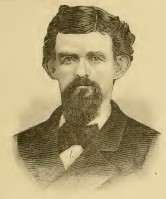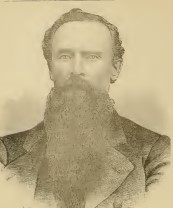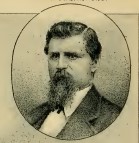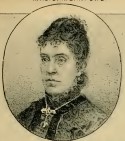|
 WILLIAM MURPHY ------The
subject of this sketch, and whose name stands at
the head of this article, was born in the city of
New Orleans, State of Louisiana, on the thirteenth
day of May, a. d. 1843, where he remained with his
parents till the year 1853; his father during that
time being engaged in buying and selling cotton,
once recognized as the "king" of Southern
commerce, if not of the United
States. WILLIAM MURPHY ------The
subject of this sketch, and whose name stands at
the head of this article, was born in the city of
New Orleans, State of Louisiana, on the thirteenth
day of May, a. d. 1843, where he remained with his
parents till the year 1853; his father during that
time being engaged in buying and selling cotton,
once recognized as the "king" of Southern
commerce, if not of the United
States.
During the year 1853, hearing much
of the golden paradise of the Pacific Coast, his
father disposed of his business in New Orleans,
and, following the sun in his western course,
accompanied by his family, came to California, by
way of the Nicaragua route, settling in Tuolumne
County. There he engaged in mining till his death
in 1879.
William grew up to manhood in
Tuolumne County, at times engaged in mining, after
arriving at sufficient age to be of assistance to
his father, and at other times in butchering, to
supply the mining camps in the vicinity. In 1870,
leaving Tuolumne County, he removed to St. Clair,
Churchill County. Nevada, and again engaged in
butchering, a business he had been largely engaged
in since his early youth, and in connection with
that folIowed farming, and is largely interested
in stock-raising, growing and feeding many of the
animals which supply his main business. In 1878
his integrity and business ability placed him
prominently before the people for their suffrage,
for the responsible position of Treasurer of the
county, to which office he was elected, and so
acceptably discharged his duties, that he was
re-elected in 1880, which office he now continues
to fill, with honor and credit to himself, and to
the satisfaction of his constituents. On his
election in 1878, the duties of his office
requiring his presence at Stillwater, the county
seat, he removed to that place, and has since
resided there.
On the fourteenth of December, 1879, he
married Miss Elizabeth McGee. He is the owner of
160 acres of excellent farming land on the west
side of Stillwater, and an equal partner in the
ownership of the irrigation ditch now under
construction taking water from Stillwater Slough
and running across his farm, supplying it with
water for all needful
purposes.
W. H. A. PIKE -------Was born in
Cornish, York County, Maine, on the twenty-fourth
day of January 1854. His early life was passed on
the farm of his father, Henry B. Pike, who was one
of the most extensive farmers and the leading
cattle merchant of the State of Maine. The subject
of our sketch received a liberal academy
education, first at the Cornish High School,
Limerick Academy, and afterward at the Oxford
Normal Institute at South Paris, Maine. His
aspirations to become a lawyer prompted him to
enter Bowdoin College, where he was admitted to
the Freshman Class in
1873.
In 1874, Mr. Pike decided to discontinue
his collegiate course, and go West, and we next
find him settled in Churchill County, Nevada,
where, for several years he was engaged in
teaching school; and, being one of the few "born
to command," his fitness for a teacher of the
young was readily perceived, and he was admitted
to be one of the most successful instructors that
ever presided over a school in the State of
Nevada. At length becoming tired of the
confinement consequent with his profession, he
turned his attention in other directions, and
engaged in the practice of law. In this, as in all
other things to which he has given his attention,
he became eminently successful. In connection with
his profession, he has been engaged in
stock-raising, and is at the present time one of
the principal cattle-raisers in his county. He was
married in 1877 to Miss Ida M. Kenyon, of
Churchill County, a lady of rare accomplishments,
who was one of the first white children born in
Nevada.
 J. W. RICHARDS ------Born in
Bath County, Kentucky, the third day of November,
1839, is one of the first settlers of Old River,
Nevada. Removing with his parents, in 1856, to
Ralls County, Missouri, where he remained
assisting his father with the labors of the farm
till 1862, when, making the acquaintance of Dr.
Glenn, of Colusa County, California, he purchased
a number of mules, and in company with him crossed
the plains into California as far as Sacramento,
where he remained three months, till the fall of
1863, at which date he came to Churchill County,
Nevada, at that time almost on the verge of
civilization in its outreach from the shores of
the Pacific over and beyond the snow-capped peaks
of the Sierra. His youth and early years of
manhood having been passed in the honorable labors
of the farm and the cultivation of the early, he
was well able to judge of the adaptability of
lands about the Carson to the raising of grain,
when properly prepared. J. W. RICHARDS ------Born in
Bath County, Kentucky, the third day of November,
1839, is one of the first settlers of Old River,
Nevada. Removing with his parents, in 1856, to
Ralls County, Missouri, where he remained
assisting his father with the labors of the farm
till 1862, when, making the acquaintance of Dr.
Glenn, of Colusa County, California, he purchased
a number of mules, and in company with him crossed
the plains into California as far as Sacramento,
where he remained three months, till the fall of
1863, at which date he came to Churchill County,
Nevada, at that time almost on the verge of
civilization in its outreach from the shores of
the Pacific over and beyond the snow-capped peaks
of the Sierra. His youth and early years of
manhood having been passed in the honorable labors
of the farm and the cultivation of the early, he
was well able to judge of the adaptability of
lands about the Carson to the raising of grain,
when properly prepared.
Engaging in farming, he was among
the first who encouraged the growing of grain at
Stillwater, and the originator of the plan, since
so successfully reduced to practice, for
irrigating the land by means of ditches from
Stillwater Slough, he remained at Old River,
farming, till 1867, when, joining a party of
Government surveyors under Colonel Monroe, he
accompanied them in the survey of Arizona,
returning in the fall of
1860.
On his return the people gave due
evidence of their appreciation of his integrity
and ability by placing him in nomination for the
office of County Recorder, and full assurance, by
electing him, in which capacity he continued to
serve the people till 1875, at which time he was
transferred to the office of County Clerk, the
duties of which office he continued to discharge
till 1880. In November, 1880, he was elected to
represent the people in the Assembly of the State
for the year 1881.
In January, 1871, Mr. Richards, ambitious
to acquire the art of telegraphy, commenced, under
such instructions as could then be obtained, to
practice, during all his leisure moments on the
instruments of the Overland Telegraph Line, and so
perfected himself that the company, in December,
1874, appointed him their operator and agent, and
made his office a repair office, with salary, and
he now has charge of the line from Virginia City
to Austin.
In 1878 he was appointed Postmaster at
Stillwater, which position he still
retains.
 J. M. SANFORD ------The
subject of the following sketch is a native of New
York State, where he lived until 1855, at which
time he removed to Wisconsin, and was engaged as a
tiller of the soil for the succeeding six
years.
In 1861 he crossed the plains, and arrived
at Ragtown, Churchill County, Nevada, in the fall
of the same year, where he remained about one
year. He then went to Sacramento, California, and
after a few month's stay there, returned to
Nevada, and locating again in Churchill County,
engaged in the business of stock-raising and
ranching. By strict attention to his business he
was soon on a firm basis in that line. J. M. SANFORD ------The
subject of the following sketch is a native of New
York State, where he lived until 1855, at which
time he removed to Wisconsin, and was engaged as a
tiller of the soil for the succeeding six
years.
In 1861 he crossed the plains, and arrived
at Ragtown, Churchill County, Nevada, in the fall
of the same year, where he remained about one
year. He then went to Sacramento, California, and
after a few month's stay there, returned to
Nevada, and locating again in Churchill County,
engaged in the business of stock-raising and
ranching. By strict attention to his business he
was soon on a firm basis in that line.
 He was elected one of the
Commissioners of this county in 1869, and one year
later removed to the county seat, Stillwater,
where he has since resided. In 1873 he
was chosen to represent his people in the State
Legislature, and was re-elected in 1875. In this
honorable position he served his constituents in a
satisfactory manner, and won laurels in that body
that will remain green for years to come. He has
also held the office of Justice of the Peace and
Deputy Sheriff, and today stands firm in the
estimation of his
fellowmen. He was elected one of the
Commissioners of this county in 1869, and one year
later removed to the county seat, Stillwater,
where he has since resided. In 1873 he
was chosen to represent his people in the State
Legislature, and was re-elected in 1875. In this
honorable position he served his constituents in a
satisfactory manner, and won laurels in that body
that will remain green for years to come. He has
also held the office of Justice of the Peace and
Deputy Sheriff, and today stands firm in the
estimation of his
fellowmen.
In 1870 he opened a hotel,
and has since catered to the public in a style
known only to those who "know how to keep
hotel."
HENRY THEELEN -----Is a native of
Germany, born on the fourteenth of January, 1832.
He emigrated to the United States when he was
about twenty-nine years of age, settling in
Illinois, where he remained employed on a farm
until 1860, when, with others, he emigrated to
California, settling at Red Bluff. Up to 1873
he was employed in teaming, carrying on a
successful business between California and Nevada,
and as far as Idaho, and to quite a number of
other points. In that year he sold his teams and
purchased the old St. Clair Station on Old River,
Churchill County, Nevada, where he is still
settled, and is the proprietor of that very
conveniently located station, which he
successfully manages for the accommodation of
travelers, but more particularly for teamsters who
team between Candelaria, Grantsville and
Wadsworth.
Mr. Theelen has 800 acres of fine
land, extending for three miles along Old River,
200 acres of which are cultivated and enclosed
with fence.
With unfailing success he raises each year
an immense crop of alfalfa, which he sells to the
teamsters, and also feeds to some very fine stock
owned by himself. He owns a toll-bridge crossing
the Old River, from which he derives a handsome
revenue.
He also raises from 500 to 600 bushels of
grain per year, and his alfalfa fields cover at
least 160 acres. Mr.
Theelen is extensively known, and throughout his
large acquaintance is very much esteemed and
respected. He is a married man, having married in
1874, and is the father of two children: Kate,
aged six years, and Annie, who is four years
old.
D. M. WIGHTMAN -----Claims Hancock
County, Illinois, as the place of his nativity,
and was born on May 3, 1839. When four years of
age his parents died, leaving him to the care of
his uncle. At seven years of age he removed to
Jackson County, Michigan, where he remained until
he was seventeen years of age. In the year 1856,
he went to Utah, after stopping in Iowa a short
time.
His next removal was to Ophir,
Virginia City, Nevada, reaching that wonderful
mining district on the fourth of July, 1859 In
epitomizing a history of any of the brave men who
turned their faces towards the setting sun, in
those earlier days when hardships were as much to
be expected as wolves and Indians, they who have
followed after, when railroad travel and long
cultivation of lands have superseded the first
named, and bravery and numbers have banished the
two last named, will find but scant justice done
to the subjects of our sketches. But to many
readers, memories of those earlier days will be
made vividly real by what we write; and to another
class of readers, each advance made toward the
then outposts of civilization will need but few
words to suggest the long, patient and courageous
struggle of those pioneers, who have but this
terse record to tell of lives and adventures which
will soon sound as unreal as stories of
romance.
In the fall of 1860, Mr. Wightman
settled on his present ranch on the Carson Sink,
where he now owns 1,200 acres of land, all fenced,
100 acres of which are cultivated in grains. He
has a good breed of stock, both cattle and horses,
ranging over his rich pastures. He cuts about 400
tons of hay per year. The old adobe house, as
shown in the view, was occupied by him as a
residence until the year 1880, when he erected a
fine frame house, which he now
occupies.
On the nineteenth of July, 1865, he
married Miss Sarah J. McGee; seven children bless
their union, five sons and two
daughters.
His ranch is located on the Belleville
road, thirty-five miles from Wadsworth. In 1870,
he was elected County Assessor, and discharged his
duties so acceptable that he was continued in that
office until 1876, a period of six years. Since
then, the citizens of his county, appreciating his
worth, have again called him to the responsible
position of County Commissioner of Churchill
County, the duties of which office he is now
discharging with like faithfulness and
ability.
The information on Trails
to the Past © Copyright
may be used in personal family history research,
with source citation. The pages in entirety may
not be duplicated for publication in any fashion
without the permission of the owner. Commercial
use of any material on this site is not
permitted. Please respect the wishes of
those who have contributed their time and efforts
to make this free site possible.~Thank you! |